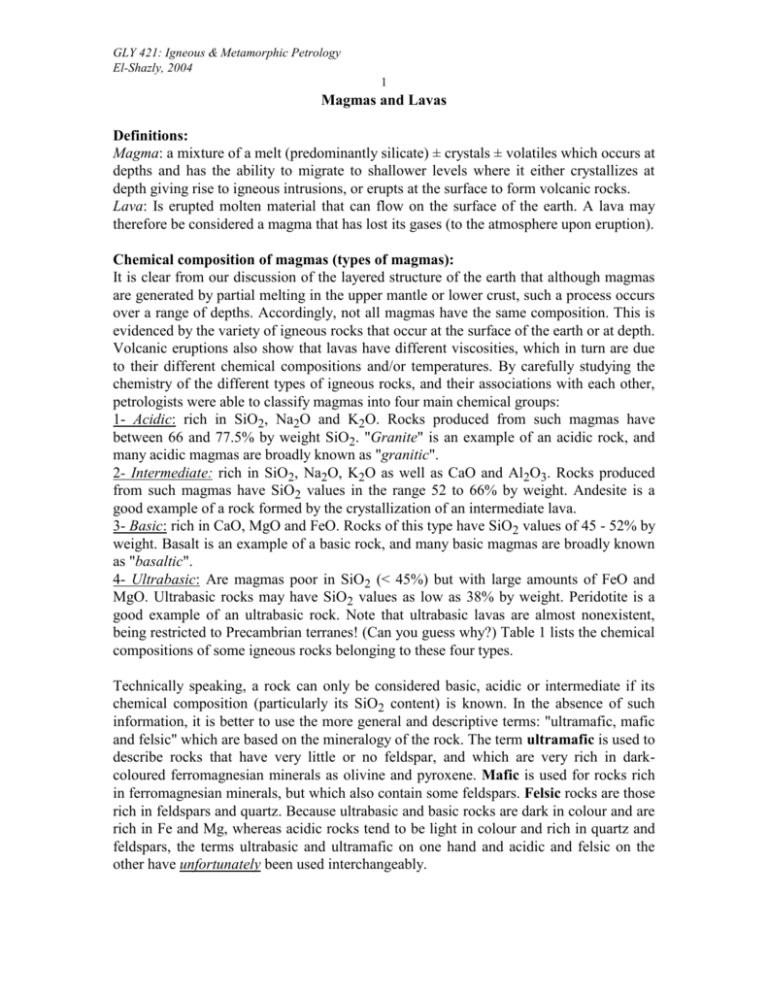Magmas and Lavas
advertisement

GLY 421: Igneous & Metamorphic Petrology El-Shazly, 2004 1 Magmas and Lavas Definitions: Magma: a mixture of a melt (predominantly silicate) ± crystals ± volatiles which occurs at depths and has the ability to migrate to shallower levels where it either crystallizes at depth giving rise to igneous intrusions, or erupts at the surface to form volcanic rocks. Lava: Is erupted molten material that can flow on the surface of the earth. A lava may therefore be considered a magma that has lost its gases (to the atmosphere upon eruption). Chemical composition of magmas (types of magmas): It is clear from our discussion of the layered structure of the earth that although magmas are generated by partial melting in the upper mantle or lower crust, such a process occurs over a range of depths. Accordingly, not all magmas have the same composition. This is evidenced by the variety of igneous rocks that occur at the surface of the earth or at depth. Volcanic eruptions also show that lavas have different viscosities, which in turn are due to their different chemical compositions and/or temperatures. By carefully studying the chemistry of the different types of igneous rocks, and their associations with each other, petrologists were able to classify magmas into four main chemical groups: 1- Acidic: rich in SiO2, Na2O and K2O. Rocks produced from such magmas have between 66 and 77.5% by weight SiO2. "Granite" is an example of an acidic rock, and many acidic magmas are broadly known as "granitic". 2- Intermediate: rich in SiO2, Na2O, K2O as well as CaO and Al2O3. Rocks produced from such magmas have SiO2 values in the range 52 to 66% by weight. Andesite is a good example of a rock formed by the crystallization of an intermediate lava. 3- Basic: rich in CaO, MgO and FeO. Rocks of this type have SiO2 values of 45 - 52% by weight. Basalt is an example of a basic rock, and many basic magmas are broadly known as "basaltic". 4- Ultrabasic: Are magmas poor in SiO2 (< 45%) but with large amounts of FeO and MgO. Ultrabasic rocks may have SiO2 values as low as 38% by weight. Peridotite is a good example of an ultrabasic rock. Note that ultrabasic lavas are almost nonexistent, being restricted to Precambrian terranes! (Can you guess why?) Table 1 lists the chemical compositions of some igneous rocks belonging to these four types. Technically speaking, a rock can only be considered basic, acidic or intermediate if its chemical composition (particularly its SiO2 content) is known. In the absence of such information, it is better to use the more general and descriptive terms: "ultramafic, mafic and felsic" which are based on the mineralogy of the rock. The term ultramafic is used to describe rocks that have very little or no feldspar, and which are very rich in darkcoloured ferromagnesian minerals as olivine and pyroxene. Mafic is used for rocks rich in ferromagnesian minerals, but which also contain some feldspars. Felsic rocks are those rich in feldspars and quartz. Because ultrabasic and basic rocks are dark in colour and are rich in Fe and Mg, whereas acidic rocks tend to be light in colour and rich in quartz and feldspars, the terms ultrabasic and ultramafic on one hand and acidic and felsic on the other have unfortunately been used interchangeably. GLY 421: Igneous & Metamorphic Petrology El-Shazly, 2004 2 Table 1: Average chemical compositions of selected igneous rock types Oxide SiO2 TiO2 Al2O3 Fe2O3 FeO MnO MgO CaO Na2O K2O H2O CO2 P2O5 Acidic (Granite) 71.3 0.31 14.32 1.21 1.64 0.05 0.71 1.84 3.68 4.07 0.77 0.05 0.12 Intermediate (Andesite) 57.94 0.87 17.02 3.27 4.04 0.14 3.33 6.79 3.48 1.62 1.17 0.05 0.21 Basic (Basalt) 49.2 1.84 15.74 3.79 7.13 0.2 6.73 9.47 2.91 1.1 0.95 0.11 0.35 Ultrabasic (Peridotite) 42.26 0.63 4.23 3.61 6.58 0.41 31.24 5.05 0.49 0.34 3.91 0.30 0.10 In the course of studying igneous rocks, it was found that acidic rocks melt at lower temperature compared to basic and ultrabasic rocks. Because melting is the reverse of crystallization, understanding how a rock melts will help us understand the process of magma formation, as well as the process of formation of igneous rocks from a magma. Formation of magmas: The temperature in the earth generally increases regularly with increasing depth, and the variation of temperature with depth in a specific area and at a specific time in the earth's history is known as the "geotherm", the slope of which is known as the "geothermal gradient". Different areas have different geothermal gradients (Fig. 1) which may also change over time (as the tectonic setting of that area changes). As you are aware, the highest geotherms occur beneath mid-oceanic ridges (Fig. 1). If a rock is buried deep below the surface, it will first be metamorphosed, then if the melting point of some of its constituent minerals is reached, the rock will begin to melt. Keep in mind that the melting temperatures of minerals will change as a function of pressure along a curve known as the melting curve. Because different minerals have different melting curves, and because a rock is an aggregate of different minerals, melting of a rock will take place over a range of temperatures bounded by two curves: the solidus and the liquidus (Fig. 2). This is the process known as "partial melting", since only part of the rock melts at any given temperature. The solidus is the curve of all temperatures below which the rock is completely in the solid state. The liquidus is the curve joining all temperatures above which the rock is totally molten. Between the two curves, solids and a melt coexist in equilibrium. GLY 421: Igneous & Metamorphic Petrology El-Shazly, 2004 3 In order to achieve any degree of melting of a particular rock within the crust or mantle, temperatures must exceed those defined by the solidus of that rock. Figure 3 shows the relationship between two different geotherms (one beneath the continents, and the other beneath the oceans), and the melting curves of an acidic rock (a granite, in the presence of H2O; Fig. 3b) and that of an ultrabasic rock (a dry peridotite; Fig. 3a). In either case, melting can only occur at depths greater than those defined by the intersection of the geotherms with the solidus for that rock (shaded areas). It is clear from this figure that because of the different melting temperatures of a wet granite and a peridotite, an acidic melt can be generated at depths as low as 35 km, whereas a basic magma may require depths of >300 km to form! In order to understand how a magma is actually generated in the mantle, we need to know what kind of rocks occur in the mantle. We have already decided that most magmas are produced in layers (a) - (d) of the mantle (collectively known as the upper mantle), and that only small amounts of magmas form in the lower crust. The upper mantle layers consist of different types of peridotite. In the uppermost parts of the lithospheric mantle (especially beneath the oceanic crust), the pressures are low enough for plagioclase to be stable, and the peridotites at these depths may contain minor amounts of plagioclase, in addition to the common Opx, Cpx and olivine. Such peridotites are therefore called plagioclase lherzolites. At greater depths, plagioclase becomes unstable, and the mantle consists predominantly of spinel lherzolites. At greater depths, garnet becomes a common constituent of peridotites which are then known as garnet lherzolites. These relations are shown on Fig. 2. Because different layers of the mantle have different compositions, partial melting at different depths in the mantle will produce different types of magma. However, Fig. 2 also shows that an average geotherm does not intersect the solidus of mantle rocks, suggesting that under normal geothermal conditions, it is not possible to produce a magma from the mantle by partial melting! Partial melting in the mantle will therefore take place if: (a) the geotherm is perturbed, shifting to higher temperatures. (b) H2O or CO2 are added to the mantle, thus shifting their solidi to lower T (Fig. 4) (c) Adiabatic decompression: This model suggests that packets of mantle material can rise very quickly from the deep parts of the mantle into shallower levels while still maintaining their temperature. This causes these packets to cross the solidus of mantle lherzolites, and thus undergo partial melting. A good example of such "packets" is rendered by mantle plumes. Convection in the mantle is believed to be the driving force behind the adiabatic rise of mantle material. Figure 5 shows the process of adiabatic decompression. Once the mantle undergoes partial melting by about 20% or more, the melt fraction (or primary magma) is squeezed out of it, and begins its journey towards the surface of the earth (Fig. 6). Keep in mind that the mantle layers are not necessarily homogeneous, and that they may contain (in addition to basaltic magma) eclogites (Gt + Cpx), harzburgites (Opx + Ol) and dunites (monomineralic rocks of olivine). The latter two rock types are believed to represent what is left behind after partial melting. Accordingly, if the mantle is found to contain considerable amounts of harzburgite + dunite, it is often termed GLY 421: Igneous & Metamorphic Petrology El-Shazly, 2004 4 "depleted mantle" meaning a mantle that has undergone significant partial melting. Figure 7 shows the relationship between the composition of the magma generated by partial melting, and the depth at which such magmas are generated. Structure of silicate liquids By definition, a magma consists of a melt ± suspended crystals ± dissolved or exsolved gases. This shows that the melt (usually a silicate liquid) is the main constituent of a magma. It is therefore important to understand its structure, which will in turn help us understand the physical properties of magmas. Silicate melts consist of polymers of interconnected by distorted Si-O tetrahedra, with other major ions such as Na, K, Al, Ca, Fe and Mg occurring in looser coordination with O (Fig. 8). In general, elements can be grouped into two main groups as far as their effect on the degree of polymerization of the silicate liquid: (a) Network formers: Si, Al, Na, K, Rb, Cs, Ti and P. Al3+ and a monovalent ion can substitute for Si4+, hence the network forming capability of these elements. Ti and P have large charges (4 and 5, respectively) which allow them to act as network formers. (b) Network modifiers: Fe, Mg, Ca and Mn, all of which substitute into the melt structure by breaking the Si - O bonds. Note that in alkalic magmas in which Na + K > Al, Na and K become network modifiers instead of network formers. Similarly, in highly aluminous melts, Al will tend to occupy the octahedral (instead of the tetrahedral) sites, and will also become a network modifier. H2O, Cl, F, and S are all network modifiers. H2O being the most common volatile in magmas plays a major role in breaking Si-O bonds and lowering the viscosity of the melt (Fig. 9). CO2 on the other hand appears to be a network former, binding broken Si-O bonds back together, although its role is not exactly known. Volatiles in magmas Volatiles in magmas are either dissolved (at high pressures) or exsolved (closer to the surface, where the pressure buildup may result in the violent eruptions of some volcanoes). Experimental studies have shown that magmas can dissolve more gases than have actually been observed. However, determination of the exact amount or composition of volatiles contained in a magma is very difficult, as magmas tend to lose volatiles to the atmosphere on eruption, or to the intruded country rocks during their slow cooling. Nevertheless, methods of estimating the nature and amount of volatile constituents of a magma include: i) analysis of the tops of pillow lavas, and counting their vesicles. ii) analysis of melt inclusions in crystals iii) analysis of quenched magmas iv) phase equilibria experiments. GLY 421: Igneous & Metamorphic Petrology El-Shazly, 2004 5 In addition, volcanic eruptions give us some idea of the amount and composition of volcanic gases. Table 1 lists the composition of volcanic gases. All of these studies show that magmas have ~ 1% by weight volatiles, and that H2O is the most common volatile constituent of acidic magmas, whereas CO2 is more common in basaltic ones. Although this may seem like a very small amount, the low molecular weight of volatiles ensures that they will occupy a significantly larger % of the magma by volume. The decrease of the H2O/CO2 ratio as the magmas become more basaltic or more alkalic is due to the fact that CO2 and S gases are more soluble in basaltic magmas. On the other hand, F and Cl are more soluble in acidic magmas. Because H2O is the most common volatile constituent of the magma, it is important to understand the form in which it enters (and dissolves in) a magma. Figure 9 shows that H2O breaks Si-O bonds and is therefore one of the most important network modifiers. Stopler (1982) has shown that at low concentrations of H2O in the magma, this H2O is in the form of OH-; at higher concentrations, H2O enters the magma in its molecular form (Fig. 10). Factors affecting the solubility of gases in magmas: i) pressure: the higher the P, the larger the wt% of H2O dissolved (Fig. 11a). ii) temperature: the higher the T, the lower the wt% of H2O dissolved (Fig. 11b). iii) chemical composition of the magma: acidic magmas contain a larger amount of volatiles (Fig. 11a). This is because such magmas have already undergone a significant amount of crystallization of anhydrous phases, thus concentrating the volatiles. iv) composition of the volatiles: An increased amount of CO2 in the volatiles decreases the solubility of H2O in the magma (Fig. 11c). Physical properties of magmas 1) Temperature Temperatures of magmas can be inferred from: i) direct measurement of the temperature of lavas using optical pyrometers ii) direct measurement of lava temperatures using thermocouples iii) phase equilibria experiments iv) application of well calibrated geothermometers. Direct measurement methods yield temperatures in the range: 800 - 1200°C. The lower temperatures represent those determined for acidic rocks or partially crystalline lavas, whereas the higher ones are for basalts. Because most solidi have positive slopes (i.e. the meting temperature increases by ~ 3°C/km, the original temperatures of a magma generated at a depth of ~ 50 km will be 150°C higher than that determined for the corresponding lava at the surface. GLY 421: Igneous & Metamorphic Petrology El-Shazly, 2004 6 2) Thermal conductivity, specific heat and heat of fusion: The thermal conductivity of both rocks and magmas is very low. It generally increases with increasing temperature. Acidic magmas have a higher thermal conductivity compared to basic ones. Fig. 12 shows the relationship between thermal conductivity and T for several types of magmas. The specific heat (or heat capacity Cp), defined as the heat necessary to raise the temperature of 1 gm of a substance by 1°C, is very low for magmas (~0.3 cal/gm). On the other hand, the heat of fusion of igneous rocks (or the heat of crystallization of a magma, defined as the heat released during the crystallization of 1 gm of a melt) are relatively large (~ 65 - 100 cal/gm). This means that, as the magma is crystallizing, it releases a large amount of heat. Because of the low Cp of the same magma, the heat released during crystallization will to a certain extent "raise" the temperature of the magma while the same magma is "cooling" and crystallizing. The overall effect is to maintain the temperature of the magma over a long period of time (i.e. cooling during crystallization will be slow). However, as soon as the magma crystallizes, the igneous rock will cool much more rapidly. 3) Viscosity Viscosity is a measure of the resistance to flow of any fluid substance. Fluids are broadly grouped into two groups according to their viscosity: (i) Newtonian fluids: those which respond directly by flow to any kind of applied shear stress, and (ii) Bingham fluids: those which have a finite yield strength, and will not flow unless this strength is "overcome" by the applied shear stress. Magmas are Bingham fluids. Factors affecting the viscosity of a magma: i) temperature: the higher the T, the lower the viscosity (Fig. 13a & c) ii) pressure: has a small effect on viscosity; the higher the pressure, the lower the viscosity (Fig. 13d). iii) composition: Acidic magmas are more viscous than basic ones. This is simply a function of the percentage of network formers and network modifiers in each magma; the higher SiO2 content of acidic magmas ensures that they have the larger % of network formers. This relationship is shown in Fig. 13a. iv) amount and nature of volatiles: Again this is a reflection of the ability of volatile components to act as network modifiers or (in case of CO2) as network formers. Addition of a small amount of H2O to a magma drastically lowers its viscosity (Fig. 13c), especially if this magma is acidic or intermediate. On the other hand, addition of H2O to an olivine melt will only have a minor effect on its viscosity. This is because H2O breaks Si-Al-O bonds, and Olivine has no Al! Viscosity of a magma largely controls the structures formed upon its crystallization. For example, fissure eruptions or shield volcanoes form from basaltic lavas which have low viscosities, whereas cumulo-domes and plugs are formed from high viscosity acidic lavas. GLY 421: Igneous & Metamorphic Petrology El-Shazly, 2004 7 4) Density The density of a magma is one of the most important factors controlling its physical and chemical behavior. Density plays a role in controlling the movement of magmas to shallower levels. Moreover, density contrast between a silicate melt and any minerals that may have crystallized from it plays a role in the differentiation of this magma. Magma densities range between 2.2 and 3.1 g/cm3 Mafic minerals such as pyroxenes, olivines and amphiboles are usually denser than the magma, and have a tendency to sink to the bottom of the magma chamber, resulting in a change in the chemical composition of the remaining magma. On the other hand, only calcic plagioclases may be denser than some magmas, but sodic plagioclases and nepheline usually float on the top of all magma. The velocity at which a mineral sinks to the floor of a magma chamber can be estimated by Stokes' law: v = 2 g r2(1-2)/9 where v is the settling velocity, r is the radius of the settling crystal (assuming it has a spherical shape), (1-2) is the density contrast between the magma and the crystal, and is the viscosity of the magma. However, keep in mind that for a crystal to sink, the gravitational force acting on it must be able to exceed the yield strength of the magma. Factors affecting the density of a magma: i) temperature: the higher the T, the lower the density (Fig. 14a) ii) pressure: the higher the pressure, the higher the density. Accordingly, the density of a magma will increase with increasing depth, until this magma is actually denser than the solid rocks (this is because fluids are more compressible than solids). This happens at depths of ~ 400 km. Accordingly, magmas generated from depths > 400 km do not rise to the surface! iii) composition: The density of a magma depends largely on its Fe content. Accordingly, basic magmas are denser than acidic ones (Fig. 14a & b). This plays a major role in differentiation (Fig. 14b). Movement of magmas: Now that we understand how a magma is generated, and have some knowledge of its physical and chemical properties, we need to understand how it moves. Movement of magmas is triggered essentially by density contrast between it and the surrounding or overlying rocks, and is controlled to a large extent by its viscosity. As soon as a melt is formed in lower crust or upper mantle (at depths < 400 km), it will have a tendency to rise to shallower depths by virtue of its lower density. This movement is known as "diapiric rise" (Fig. 14). Movement of magma will also take place through connected pores and channelways, essentially following the laws of fluid flow through porous media. At shallow depths, magmas migrate along fissures and fractures. As the magma moves, it essentially creates new channelways for itself by engulfing country rocks, and possibly melting or reacting with them (a process known as assimilation). The whole process describing the movement of magmas at shallow depths by engulfing country rocks is known as "stoping". GLY 421: Igneous & Metamorphic Petrology El-Shazly, 2004 8 While the magma is migrating to shallower levels, it loses heat, and begins to crystallize. The processes of differentiation (which include assimilation) also cause the magma to change its composition. Such compositional changes will change the density and viscosity of the magma, and hence affect its ability to continue its journey to the surface. For example, crystallization of 40 - 50% of the magma (with the crystals remaining suspended in it) will increase its viscosity so much that its rate of flow will be too slow, and it will probably never reach the surface. It is therefore clear that lavas on the surface of the earth are not representative of the original magmas from which they form, and that the lithosphere acts as a barrier that filters out magmas that are denser than its constituent rocks or too viscous to flow through its narrow channelways. Magmas that do not reach the surface, will end up crystallizing at depths as intrusive rocks. Before crystallizing, such magmas pile up in one place referred to as a magma chamber, where they begin to lose heat (± some volatiles??) to the surrounding country rocks. The loss of heat may not be homogeneous throughout the chamber, which in turn causes different parts of the chamber to have different temperatures (i.e. results in the development of thermal gradients within the chamber). The onset of crystallization will have a similar effect, and the possible removal of crystals from parts of the magma (or assimilation of country rocks from the roof of the magma chamber) may also cause the chamber to develop compositional gradients. Either one of these processes may cause the magma to convect by developing simple convection cells (Fig. 16a). Both thermal and compositional gradients operating simultaneously may cause the development of complex convection cells, a process called double diffusive convection (Fig. 16b - d). We will examine the effects of these processes in more detail when we discuss the process of differentiation.







